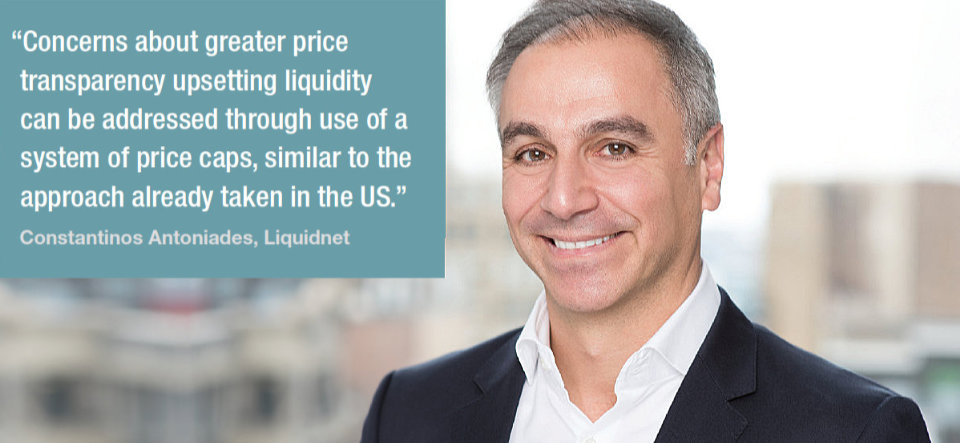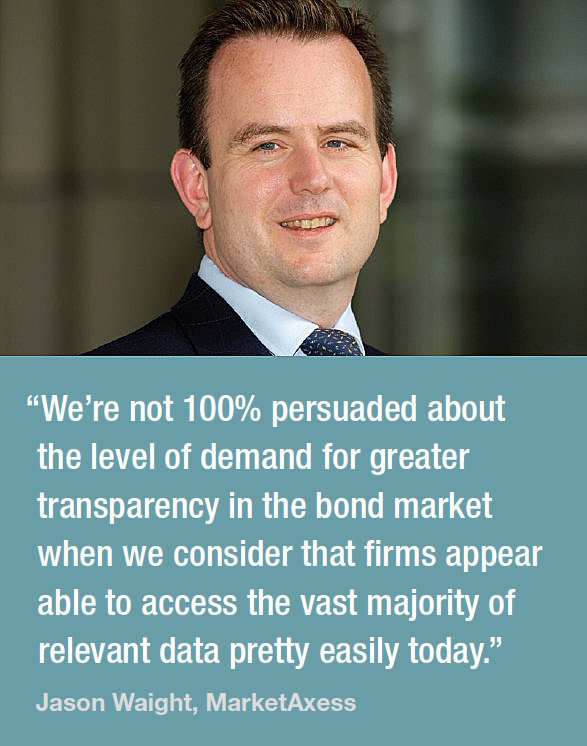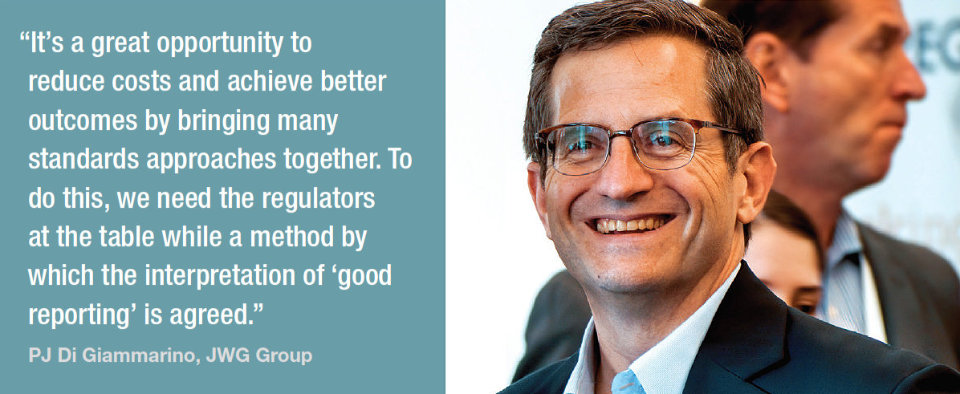Where European bond market infrastructure has lagged behind US, traders – and therefore investors – have suffered.
From a promised age of enlightenment, many traders found themselves in the dark in March 2020. MiFID II, which came into effect in January 2018, was supposed to have heralded a new electronic European bond market. The directive tried to balance the greater efficiency and transparency required to deliver best execution with the need to support a fragile liquidity ecosystem.
But the seeds sown in 2018 have not flourished as hoped. Whilst US-based traders are informed by near real-time consolidated price feeds, such as TRACE for corporate bonds and EMMA for municipal bonds, their European counterparts are left to ponder the trail of crumbs offered by MiFID II’s post-trade transparency regime.

“MiFID II post-trade data is one of multiple pricing sources we use, but it’s not the most relevant. Bilateral connectivity with dealers provides us with more meaningful price information,” says Yannig Loyer, global head of trading, AXA Investment Managers.
With no central exchange mechanism and event-driven demand beyond the most liquid issues, fixed-income price discovery has always been a somewhat convoluted affair, with buy-side traders divining best price from a variety of market soundings, historically focused on bank inventory, but increasingly multilateral.
MiFID II introduced post-trade transparency rules to stimulate the availability of pricing and transaction data. But the data generated by trading venues and approved publication arrangements (APAs) has proved inaccessible and unreliable – and costly to aggregate, with re-sellers charging “significant six-digit yearly” fees according to the Greenwich Associates report ‘2019 European Fixed-Income Investors’.
Almost 280 APAs and trading venues report non-equity trades, but 88% of volumes are reported by just four1. It is also incomplete as national regulators permit use of multiple deferrals and waivers, meaning publication of a significant proportion of trades is delayed, for up to a month.
“Aggregating data from the APAs into a single consolidated tape could be useful,” Loyer notes. “MiFID II data as currently published is very difficult to use, not because of coverage, but because of accessibility and fragmentation.”
Loyer’s not alone. More than 80% of respondents to a survey conducted by the International Capital Markets Association (ICMA) published in December 2019 said a consolidated tape would be beneficial. The merits of a consolidated tape to Europe’s bond markets is a key focus of a consultation paper issued by the European Securities and Markets Authority (ESMA) in March, and a wider MiFID II review launched by the European Commission’s DG-FISMA.
Failing the test
During the March liquidity crisis, electronic trading platforms reported record activity, driven partly by a growing willingness of buy-siders to make and take prices, as crisis turned to drought. But the jury is out on whether they grew market share.
“Anecdotally, we have heard that European fixed-income volumes followed a similar pattern [to the US], with higher electronic volumes, but a proportionally greater increase in voice volumes,” blogged Tom Jacques, principal at Greenwich Associates in his May 2020 report ‘Uncharted Territory in European Fixed Income.’

Moreover, trading on platforms could be very challenging as price formation via electronic means was not keeping up with prices quoted on the phone.

“Banks were on occasions quoting prices five points back from screen, even in small size,” at the height of the crisis in mid-March, says Stephanie Suriyanon, senior trader, Baillie Gifford. As a result, she largely abandoned platform-based trading for inflation-linked government bonds. “We needed continual communication with fund managers because the prices were moving so quickly. Our relationships came into play. Some banks stepped up; others just disappeared. Bid/offer spreads as much as quadrupled. Liquidity just wasn’t there in large size, so banks had to work the market.”
Over the past decade, liquid bond markets have been transitioning gradually to electronic execution, with Greenwich Associates estimating a 45% overall share of fixed-income trading in Europe2. But the regulatory framework and market structure are unsettled. Protocols and platforms vie for supremacy. Trader workflows are an evolving waterfall of ‘what-if’ scenarios, execution choices differ from near full automation to trading by appointment, sometimes within sub-sectors. In March, they varied from ISIN to ISIN and minute to minute, meaning tried-and-trusted methods often prevailed.
“During the crisis, we were reminded that fixed income is an over the counter (OTC) market,” says Loyer. “Electronic trading mechanisms – such as algorithms and all-to-all trading platforms – work fairly well in a benign environment in small size, but were nowhere to be found when the crisis struck.”
Look west
Despite apparently high levels of support, many observers are cautious about the development on a consolidated price tape, and issues remain contentious. Few fixed-income traders want their needs to get wrapped up in a cross-asset initiative, concerned that the delicate balance between transparency and liquidity is disrupted.
Many look west for a template. Refined and extended over almost two decades, TRACE is operated by FINRA, a self-regulatory organisation which owns and monetises the data through distribution and consumption fees. “Concerns about greater price transparency upsetting liquidity can be addressed through use of a system of price caps, similar to the approach already taken in the US. For any trade in investment grade bonds above $5 million, for example, the price is printed without revealing the exact size of the trade,” says Constantinos Antoniades, head of fixed income at Liquidnet.

The ICMA recently published recommendations and options for a consolidated tape3, based on soundings from an industry-wide working group. The report recommends a European consolidated tape should cover at least 80% of bond transactions by volume across all venues and APAs, It suggests Europe can learn from the US by gradually rolling out by asset class, monitoring impact on liquidity, and enforcing reporting uniformity. On governance, costs, and revenue-sharing models, the report offers a range of options, partly reflecting divided opinion among working group members, notably data vendors.
 ESMA also proposes simplification and harmonisation of deferrals. Jason Waight, head of regulatory affairs and business management, Europe at MarketAxess, suggests the large volume of deferred trades is a major reason why APAs have not usurped commercial products, such as his firm’s AxessAll, a pre-MiFID II service estimated to cover 75-80% of European bond market activity. “We’re not 100% persuaded about the level of demand for greater transparency in the bond market when we consider that firms appear able to access the vast majority of relevant data pretty easily today,” he says.
ESMA also proposes simplification and harmonisation of deferrals. Jason Waight, head of regulatory affairs and business management, Europe at MarketAxess, suggests the large volume of deferred trades is a major reason why APAs have not usurped commercial products, such as his firm’s AxessAll, a pre-MiFID II service estimated to cover 75-80% of European bond market activity. “We’re not 100% persuaded about the level of demand for greater transparency in the bond market when we consider that firms appear able to access the vast majority of relevant data pretty easily today,” he says.
Others argue this sets aside MiFID II’s commitments to investors. “The fact that the market currently relies on commercial data solutions puts smaller firms at a disadvantage. A consolidated tape would level the playing field by supplying the raw data to everyone, but still allowing scope for vendors to supply enriched data feeds,” says Liz Callaghan, director, market practice and regulatory policy, ICMA.

Baillie Gifford’s Suriyanon is sensitive to liquidity concerns, but is clear on the need for more transparency. “For me, the most valuable data from a consolidated tape is volume data, which would help me tell clients how long it will take to liquidate X amount of their portfolio,” she says, noting also its value to best execution.
The bigger picture
Bond trading does not exist in a bubble. Buy-siders’ frustration over MiFID II post-trade transparency data is set against a backdrop of rising costs, falling margins and continued uncertainty.
“Our data costs are going up both due to a lack of competition between vendors and an increase in regulatory requirements for asset managers to source more data to justify our own behaviour and best execution vis a vis clients,” says Stephane Janin, head of head of global regulatory development at AXA Investment Managers. The firm is calling on the European Commission to launch a Level 1 legislative initiative regulating data providers, covering MiFID II, ESG, index and ratings data. “We’re facing the same cost, governance, transparency and liability limitation issues from data providers across all these areas. Increasingly, we are facing the same oligopoly, due to consolidation in the sector.”
Wholesale regulation of market data will inevitably take time. And progress toward a consolidated tape for European bonds will be determined partly by the coronavirus-constrained agenda of Germany’s upcoming six-month presidency of the European Council. For some, relaxing MiFID II’s research unbundling rules is more urgent than post-trade transparency, and future UK/EU relations may demand attention.
New approaches offer scope for greater streamlining. The ICMA’s report flags the possibility of buy-side self-reporting. In February, DG-FISMA launched a tender “to assess whether machine readable and executable reporting can lead to a more effective and efficient development of reporting requirements”.

PJ Di Giammarino, CEO of regulatory think-tank JWG Group, says data could flow more seamlessly between market participants and regulators through use of a common domain model which uses machine readable rules to create a uniform language to describe transparency requirements across asset classes, aligned by a common dictionary. “It’s a great opportunity to reduce costs and achieve better outcomes by bringing many standards approaches together. To do this, we need the regulators at the table while a method by which the interpretation of ‘good reporting’ is agreed. By mutualising the interpretation of the data needs we get more effective markets as well as better oversight.”
- Consultation Paper: MiFID II / MiFIR review report on the transparency regime for non-equity instruments – ESMA (March 2020)
- Uncharted Territory in European Fixed Income (October 2019)
- EU Consolidated Tape for Bond Markets – Final report for the European Commission – ICMA (April 2020)
©The DESK 2020
©Markets Media Europe 2025













